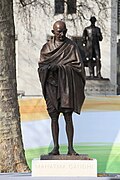Commissions
- Statue of Terence Cuneo, Waterloo station, London.
- Raoul Wallenberg Monument in Great Cumberland Place, London
- Bobby Moore statue, Wembley
- Mahatma Gandhi, Parliament Square, London
- Gurkha Soldier Monument, London
- Wolfgang Amadeus Mozart – Belgravia, London
- Falklands War Sculpture – Portsmouth
- Liberation Sculpture – Jersey, Channel Islands
- Sir Matt Busby – Old Trafford, Manchester
- Empress Elisabeth of Austria – Geneva, Switzerland
- St Richard – Chichester Cathedral
- King George VI – Britannia Royal Naval College, Dartmouth
- The Gurka Memorial – Horse Guards Avenue
- 1966 World Cup Sculpture – Newham, London
- Queen Elizabeth II – Windsor Great Park
- Queen Elizabeth, the Queen Mother – London
- Bobby Moore and Sir Alf Ramsey – Wembley Stadium, London
- United Trinity – Old Trafford, Manchester
- Sir Alex Ferguson – Old Trafford, Manchester
- Peter Osgood – Stamford Bridge, Fulham
- Korean War Memorial – London
- Statue of Constantine the Great, York
- RAF Bomber Command Memorial – London
As well as producing commissions, Jackson also creates 'studio' works, mainly theatrical subjects. One of his most celebrated works was the life-size nude, Maggie Reading.
It was announced on 6 September 2019 that Jackson had been commissioned to build the National Emergency Services Memorial which was being backed by the Duke of Cambridge and prime minister Boris Johnson. [8]





